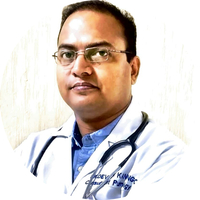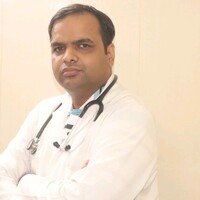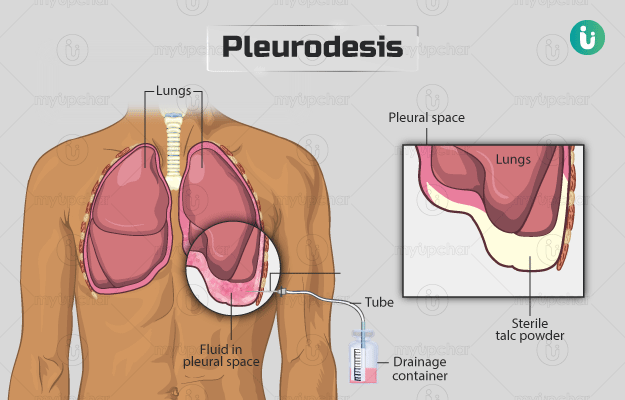Summary
A pleurodesis procedure is performed to treat (drain or vacate) fluid or air entrapped inside the pleural space. The pleural space is a cavity located between the two thin membranes (pleura) present around lungs.
Before the surgery, your doctor will ask you to undergo various tests to check the health of your lungs. You will have to fast from midnight before the surgery until the surgery is performed or until you are fit to eat/drink again.
The surgeon will insert a chest tube to drain out the trapped fluid or air and administer the medicine. The tube is required to be kept in place for at least 24 hours. During the procedure, the surgeon will inject medicines such as doxycycline or talc powder inside the pleural space in your body, which will seal the two membranes together and prevent the accumulation of fluid or air, thus helping improve your breathing.
After the surgery, proper care is advised to keep the surgical area clean and dry. The doctor will prescribe painkiller medicines for pain relief after surgery. You will be asked to revisit the hospital after seven days to get the stitches removed.
- What is pleurodesis?
- Why is pleurodesis recommended?
- Who can and cannot get pleurodesis?
- What preparations are needed before pleurodesis?
- How is pleurodesis done?
- How to care for yourself after pleurodesis?
- What are the possible complications/risks of pleurodesis?
- When to follow up with your doctor after pleurodesis?
What is pleurodesis?
Pleurodesis involves the insertion of medicines such as doxycycline or talc powder in the pleural space to treat conditions like pleural effusion and pneumothorax or collapsed lung. The medicine seals up the space between the pleura by causing swelling or irritation between the pleura. This prevents the accumulation of fluid (pleural effusion) or air (pneumothorax) inside the pleural cavity and allows the collapsed lungs to stick to the chest wall, thus easing the breathing process.
Pleurae are two thin and moist membranes surrounding the lungs. The inner layer is just outside the lungs, and the external layer is close to the ribs. Both these layers allow the lungs to expand and contract during the breathing process. The space between these two pleurae is called the pleural space.
Why is pleurodesis recommended?
Your healthcare practitioner will perform this surgery if you have pleural effusion or pneumothorax that may be caused by a liver injury or disease.
The symptoms of pleural effusion are as follows:
- Sudden or unexpected loss of weight
- Shortness of breath
- Fever or chills
- Hiccups
- Shallow breathing
- Chest pain
- Blood in cough
- Stomach pain
- Rapid heartbeat or rapid breathing
Pneumothorax may cause the following symptoms:
- Cough
- Sensations of tension, stress or anxiety
- Tightness in the chest
- Rapid heartbeat
- Chronic difficulty in breathing
- Sudden and sharp pain in the chest that worsens on coughing or deep breathing
- Blue-coloured skin because of the absence of oxygen
Who can and cannot get pleurodesis?
Your healthcare practitioner will not advise this surgery if you have the following conditions:
- Endobronchial obstruction (blockage of the main airways)
- A thick pleural lining which makes it difficult for the lungs to expand properly
What preparations are needed before pleurodesis?
Before this procedure, you will need the following preparation:
- Diagnostic tests: Your doctor will perform a complete physical examination and carefully review your medical history and order the following tests:
- Blood tests
- Spirometry (a breathing test wherein you will be asked to blow into a machine to assess your breathing capacity)
- Chest x-ray (to obtain a better view of the internal organs)
- Lung function tests (to assess the capacity and function of the lungs)
- Electrocardiogram (for measuring and evaluating the electrical activity of the heart)
- Magnetic resonance imaging or computed tomography scan along with ultrasound.
- Medicines:
- Fasting: You will have to fast from midnight before the surgery and until after surgery when you are able to eat.
- Lifestyle:
- You will be strictly advised to refrain from smoking for some time before and after surgery as smoking may increase the healing time and can cause complications. However, quitting smoking altogether would bring a lot of benefits. Read more: Effects of smoking on the body
- Inform your doctor if you consume alcohol, especially if it is more than one or two drinks a day.
- Consent: You will be asked to sign a consent form to give your permission for the surgery.
- Driving: Driving should be avoided after surgery. Therefore, you will need someone, a friend or a family member, to take you home after the procedure.
How is pleurodesis done?
For a pleureodesis proceduer, surgeon and his/her medical team will perform the following steps:
- You will be asked to lie down on an operating bench/table with your arms over your head.
- The anaesthetist will administer local anaesthesia (a medicine to numb the surgical area) or general anaesthesia to keep you asleep during the surgery.
- Then, the surgeon will make a small cut or several small cuts on your chest wall.
- He/she will insert a chest tube to extract the trapped fluid or air from the pleural space.
- Once all the fluid or air is extracted, the surgeon will place in medicines like doxycycline or talc powder inside your chest via this tube. The medicine or talc will seal the pleural layers and prevent further fluid accumulation.
- The surgeon will close the chest tube for an hour to keep the medicine in place and then re-open the tube to drain more fluid and air inside the pleural space.
- You will be required to stay at the hospital for at least a day until complete removal of the fluid or air.
- Once the drainage is complete, the surgeon will remove the chest tube and stitch up the surgical site.
How to care for yourself after pleurodesis?
Once you are home, you will need the following care:
- Wound care:
- Keep the dressing on the surgical site for at least two days.
- Gently wash the wound area with mild soap and water daily after the dressing is removed.
- Pat the wound area dry and refrain from rubbing the area until it is completely healed.
- It is normal to feel numbness, soreness and swelling around the wound area for a while after the procedure.
- Bathing or showering:
- You may be allowed to take a shower after the dressing is removed.
- Avoid soaking in bathtub or swimming until the wound heals completely.
- Medicines:
- Your doctor will prescribe medicines for pain and other necessary medicines after surgery.
- Activities:
- Your doctor may suggest you to start with light activities two weeks after surgery. Begin with short, slow walks and then gradually increase the distance for a faster recovery and avoid lifting heavy objects.
- You may be allowed to resume work four to eight weeks after surgery.
- Travel:
- As per your condition, your doctor will tell you when to begin driving.
- Avoid travelling by plane for up to six weeks after surgery.
When to see the doctor?
You must visit the doctor or hospital immediately if you experience the following symptoms:
What are the possible complications/risks of pleurodesis?
The risks of this surgery are as follows:
- Inability to properly expand the lungs
- Pain
- Infection
- Disturbance in heart rhythm
- Uncontrolled blood loss
- Injury to the lungs or blood vessels
- Air leakage
- Frequent fluid build-up in the chest cavity
- Damage to the diaphragm, food pipe or air pipe
- Death
When to follow up with your doctor after pleurodesis?
A follow-up appointment to remove the stitches will be scheduled seven days after surgery.
Disclaimer: The above information is provided purely from an educational point of view and is in no way a substitute for medical advice by a qualified doctor.
Surgery Cost In Your City
Doctors for Pleurodesis

Dr. Devesh Kanoongo
Pulmonology
18 Years of Experience

Dr Viresh Mariholannanavar
Pulmonology
2 Years of Experience

Dr Shubham Mishra
Pulmonology
1 Years of Experience

Dr. Deepak Kumar
Pulmonology
10 Years of Experience
References
- UW Health: American Family Children's Hospital [Internet]. Madison (WI): University of Wisconsin Hospitals and Clinics Authority; What is Pleurodesis?
- Oxford University Hospitals [internet]: NHS Foundation Trust. National Health Service. U.K.; Pleurodesis
- Beth Israel Lahey Health: Winchester Hospital [Internet]. Winchester. Maryland. US; Pleural Effusion
- Loyola University Chicago [Internet]. Chicago. Illinois; Pleurodesis (Obliteration of Pleural Space)
- Feller-Kopman DJ, Decamp MM. Interventional and surgical approaches to lung disease. In: Lee Goldman, Andrew I. Schafer. Goldman–Cecil medicine. 25th ed. Philadelphia, PA: Elsevier Saunders; 2016.
- Townsend Courtney, Beauchamp R. Daniel, Evers B. Mark, Mattox Kenneth. Sabiston Textbook of Surgery. 20th ed. Philadelphia, PA: Elsevier; 2017
- Robert J, et al. Murray and Nadel's Textbook of Respiratory Medicine. 6th ed. Philadelphia, PA: Elsevier Saunders; 2016.
- Guy's and St. Thomas' Hospital: NHS Foundation Trust [Internet]. National Health Service. UK; Recovery after lung surgery
- Frank sellke et al. Sabiston and Spencer Surgery of the Chest. 9th ed. Philadelphia, PA: Elsevier; 2016.















